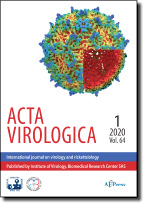Acta Virologica Vol.59, No.4, p.405-412, 2015
|
| Title: Epigenetic modification of Rta (ORF50) promoter is not responsible for distinct reactivation patterns of murine gammaherpesviruses |
| Author: B. LAPUNÍKOVÁ, K. LOPUŠNÁ, T. BENKÓCZKA, F. GOLAIS, M. KÚDELOVÁ, I. REŽUCHOVÁ |
|
Abstract: Gammaherpesviruses-encoded replication and transcription activator (Rta) (ORF50) plays an essential role in the initiation of viral lytic gene expression and reactivation from latency. The Rta expression is influenced by many viral and cellular factors, including epigenetic modifications, mainly DNA methylation and histone modifications. Murine gammaherpesvirus 68 (MHV-68), belonging to the species Murid herpesvirus (MuHV-4), is widely used as a model to study human gammaherpesvirus infections in vitro as well as in vivo. Recent studies of the MHV-68 Rta promoter revealed the effect of DNA demethylation and histone acetylation, induced by the inhibitor of histone deacetylase trichostatin A (TSA), on the MHV-68 reactivation from latency. Two other strains of MuHV-4, MHV-72 and MHV-4556, possess several unique properties, which distinguish them from strain MHV-68. Recently discovered reduced capacity of MHV-72 and MHV-4556 to reactivate from latency may be related to different methylation/demethylation patterns of the promoter regulatory region of the Rta. Here, we investigated the epigenetic regulation of the Rta promoter of three murine gammaherpesvirus strains, MHV-68, MHV-72 and MHV-4556, during latency and reactivation in vivo. However, we did not find any differences between Rta of MHV-68, MHV-72 and MHV-4556 and its epigenetic regulation during lytic infection, latency and de novo infection after ex vivo and in vivo reactivation induced by TSA. We confirmed that the treatment with TSA successfully induced demethylation of the Rta promoter regions of all three studied strains. Moreover, we have shown that the primary sequence of Rta and its promoter is identical for all three strains.
|
|
| Keywords: murine gammaherpesvirus; trichostatin A; epigenetic modification; histone acetylation; gammaherpesvirus reactivation; replication and transcription activator |
|
|
Published online: 06-Dec-2015
|
| Year: 2015, Volume: 59, Issue: 4 |
Page From: 405, Page To: 412 |
doi:10.4149/av_2015_04_405
|
|
 download file download file |
|
|
|
|
 download file
download file
